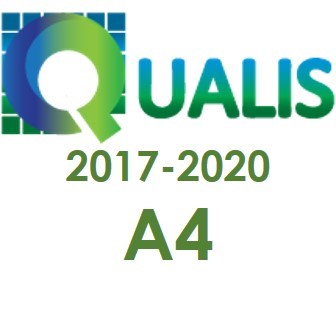Avaliação de Prováveis Produtos da Redução Eletroquímica do Corante Disperse Orange 37 via Modelagem Molecular
Palavras-chave:
Disperse Orange 37, Modelagem Molecular, Infravermelho, Deslocamentos Químicos de RMN, Degradação EletroquímicaResumo
Neste trabalho aplicou-se a Modelagem Molecular para se propor os prováveis produtos da redução eletroquímica do corante Disperse Orange 37 em meio ácido. Os espectros de infravermelho e os deslocamentos químicos de Ressonância Magnética Nuclear de 1H e 13C para os produtos propostos também foram obtidos. A toxicidade e o caráter mutagênico e carcinogênico do corante Disperse Orange 37 e dos produtos propostos para a sua redução eletroquímica em meio ácido foram previstos in silico. Estes parâmetros indicaram que uma possível rota redutiva de degradação desta espécie de poluente de efluentes industriais, geraria produtos mais tóxicos.
Downloads
Referências
CARNEIRO, P. A. et al. Assessment of water contamination caused by a mutagenic textile effluent/dyehouse effluent bearing disperse dyes. Journal of Hazardous Materials, v. 174, p. 694-699, 2010. doi: 10.1016/j.jhazmat.2009.09.106
CHUNG, K. T. Azo dyes and human health: a review. Journal of Environmental Science and Health, parte C, v. 34, n. 4, p. 233-261, 2016. doi: 10.1080/10590501.2016.1236602
DESORE, A.; NARULA, S.A. An overview on corporate response towards sustainability issues in textile industry. Environment, Development and Sustainability, v. 20, p.1439-1459, 2018. doi: 10.1007/s10668-017-9949-1
DITCHFIELD, R. Self-consistent perturbation theory of diamagnetism. 1. Gauge-invariant LCAO method for N.M.R. chemical shifts, Molecular Physics, v. 27, p.789-807, 1974. doi: 10.1080/00268977400100711
FRISCH, M. J.et al. Gaussian 09W, Revision D.01, Gaussian, Inc., Wallingford CT, 2013.
FRY, A.J. Synthetic Organic Electrochemistry. New York: Harper & Row publishers, 1972. 352p.
GARCIA-SEGURA, S. et al. Solar photoelectrocatalytic degradation of Acid Orange 7 azo dye using a highly stable TiO2 photoanode synthesized by atmospheric plasma spray. Applied Catalysis B: Environmental. v.132, p. 142-150, 2013. doi: 10.1016/j.apcatb.2012.11.037
GUARATINI, C. C. I.; ZANONI, M. V. B. Corantes Têxteis. Química Nova, v. 23, n. 1, p. 71-78, 2000. doi: 10.1590/S0100-40422000000100013
HUNGER, K. On the toxicology and metabolism of azo dyes. Chimia, v. 48, n. 11, p. 520 –522, 1994.
MALIK, A.; GROHMANN, E. Environmental Protection Strategies for Sustainable Development. New York: Springer Science + Business Media B, 2012. 595p.
MAUNZ, A. et al. Lazar: a modular predictive toxicology framework. Frontiers in Pharmacology, v.4, p. 1-10, 2013. doi: 10.3389/fphar.2013.00038
PAVIA, D. L. et al. Introdução à espectroscopia. 4 ed. Washington: Cengage Learning, 2010. 733p.
RAFII, F.; HALL, J. D.; CERNIGLIA, C. E. Mutagenicity of azo dyes used in foods, drugs and cosmetics before and after reduction by Clostridium species from the human intestinal tract. Food and chemical Toxicology, v. 35, n. 9, p. 897-901, 1997. doi: 10.1016/S0278-6915(97)00060-4
RAUF, M.A.; MEETANI, M.A.; HISAINDEE. S. An overview on the photocatalytic degradation of azo dyes in the presence of TiO2 doped with selective transition metals. Desalination. v. 276, p.13-27, 2011. doi: 10.1016/j.desal.2011.03.071
REZENDE, L. P. Modelagem Molecular na Avaliação de Mecanismo de Degradação do Corante Reactive Blue 4. 2015. Trabalho de Conclusão de Curso – Universidade Federal Fluminense, Volta Redonda.
ROBISON, T. et al. Remediation of dyes in textile effluent : a critical review on current treatment technologies with a proposed alternative. Bioresource Technology, v.77, n.3, p. 247 – 255, 2001. Doi: 10.1016/s0960-8524(00)00080-8
RODRIGUES, M. P. D. S. Modelagem Molecular de Corantes Têxteis: Estudo da Oxidação do Corante Reactive Blue 4. 2017. Trabalho de Conclusão de Curso – Universidade Federal Fluminense, Volta Redonda.
SHANKARLING, G.S.; DESHMUKH, P. P.; JOGLEKAR, A.R. Process intensification in azo dyes. Journal of Environmental Chemical Engineering, v. 5, p. 3302-3308, 2017. doi: 10.1016/j.jece.2017.05.057.
SOCIETY OF DYERS AND COLOURISTS (SDC). Colour Index: Fourth Edition Online, 2013. Disponível em: <https://colour-index.com/>. Acesso em: 18 abr. 2018.
SPARTAN’10, Wavefunction Inc. Irvine, CA 92612, U.S.A., 2011.
SZALA, M. et al. Synthesis of 5-azo-8-hydroxy-2-methylquinoline dyes and relevant spectroscopic, electrochemical and computational studies. Dyes and Pigments. v. 142, p. 277 – 292, 2017. doi: 10.1016/j.dyepig.2017.03.043
TSUDA, S. et al. DNA damage induced by red food dyes orally administered to pregnant and male mice. Toxicological Sciences, v. 61, p. 92-99, 2001. doi: 10.1093/toxsci/61.1.92
UMBUZEIRO, G. A. et al. Contribution of azo dyes to the mutagenic activity detected in the Cristais river waters. Chemosphere, v. 60, p. 55 – 64, 2005. doi: 10.1016/j.chemosphere.2004.11.100
YAMJALA, K.; NAINAR, M.S.; RAMISETTI, N.R. Methods for the analysis of azo dyes employed in food industry–a review. Food Chemistry, v. 192, p. 813-824, 2016. doi: 10.1016/j.foodchem.2015.07.085
ZANONI, M. V. B.; YAMANAKA, H. Corantes: Caracterização química, toxicológica, métodos de detecção e tratamento. São Paulo: Cultura Acadêmica, 2016. 344p.
ZHURKO, G. A.; ZHURKO, D. A. ChemCraft 1.7, Tool for Treatment of the Chemical Data. Disponível em: . Acesso em: 30 ago. 2019.
Arquivos adicionais
Publicado
Como Citar
Edição
Seção
Licença
Copyright (c) 2021 Revista Brasileira de Iniciação Científica

Este trabalho está licenciado sob uma licença Creative Commons Attribution-NonCommercial-ShareAlike 4.0 International License.




